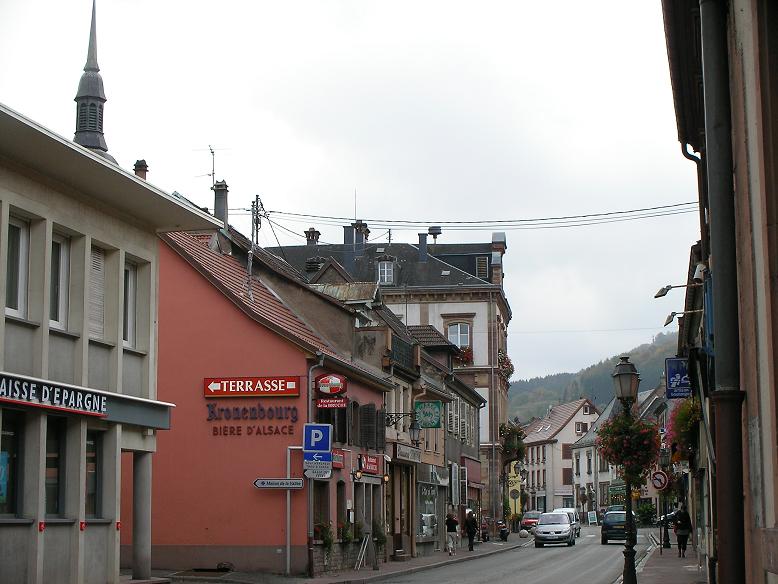Schirmeck on:
[Wikipedia]
[Google]
[Amazon]
Schirmeck () is a commune in the  It is the location of the Alsace-Moselle Memorial museum.
The name of the town means "protected place". In Lorraine dialect it is called "Chermec".
The inhabitants are known as "Schirmeckois".
It is the location of the Alsace-Moselle Memorial museum.
The name of the town means "protected place". In Lorraine dialect it is called "Chermec".
The inhabitants are known as "Schirmeckois".
Bas-Rhin
Bas-Rhin () is a department in Alsace which is a part of the Grand Est region of France. The name means 'Lower Rhine', referring to its lower altitude among the two French Rhine departments: it is downstream of the Haut-Rhin (Upper Rhine) de ...
department in Grand Est
Grand Est (; ) is an Regions of France, administrative region in northeastern France. It superseded three former administrative regions, Alsace, Champagne-Ardenne and Lorraine, on 1 January 2016 under the provisional name of Alsace-Champagne-A ...
in north-eastern France
France, officially the French Republic, is a country located primarily in Western Europe. Overseas France, Its overseas regions and territories include French Guiana in South America, Saint Pierre and Miquelon in the Atlantic Ocean#North Atlan ...
.
Geography
The town is situated on the banks of the Bruche, in the Vosges mountains. The commune extends over 1142 hectares from the Petit Donon to the Bruche, from the Grandfontaine stream to the Tommelsbach stream, taking in the Évêché hills, 832m high. The area is mountainous and belongs to the Devonian Dinant primary rocks, made up of a series ofschist
Schist ( ) is a medium-grained metamorphic rock generally derived from fine-grained sedimentary rock, like shale. It shows pronounced ''schistosity'' (named for the rock). This means that the rock is composed of mineral grains easily seen with a l ...
s and grauwackes in an irregular flow created at the bottom of a sea that was shaken by volcanic eruptions. Most of the territory is covered by forest, on steep slopes, but rich in mineral deposits, particularly iron and manganese
Manganese is a chemical element; it has Symbol (chemistry), symbol Mn and atomic number 25. It is a hard, brittle, silvery metal, often found in minerals in combination with iron. Manganese was first isolated in the 1770s. It is a transition m ...
.
The town is narrowly confined between the mountain side and the Bruche river, so a 610-metre road tunnel has been built in order to relieve traffic congestion. The bypass was opened on 28 January 2007.
History
First mention
In 1315, the town was mentioned as Schirmecke in a founding charter of the collegial church of Haslach ( Niederhaslach). It reappeared in the description of the boundaries of the lands of the abbey ofSenones
The Senones or Senonii (Gaulish: "the ancient ones") were an ancient Gallic tribe dwelling in the Seine basin, around present-day Sens, during the Iron Age and the Roman period.
Part of the Senones settled in the Italian peninsula, where the ...
, under the name ''Neufville en Barembax''; the name "new town" suggesting that it had recently been created. The town was hardly more than village, without any known privileges such as markets or freedoms. It was dependent on the See of Strasbourg but nevertheless occupied a strategic position on the Bruche, at the crossing of busy roads linking Alsace to Lorraine.
The German name Schirmeck (''opido nostro Schirmeck'') was only adopted in the acts of chancelry from 1348.
From the Middle Ages to the Renaissance
The lands on which the town grew up was a former possession of the Counts of Nordgau, acquired from the last of the line, Frederick of Leiningen (Linange) in 1239 by Berthold I of Teck, bishop of Strasbourg. It was towards the end of the thirteenth century that it became a town, without having that status. The Bishop of Strasbourg Johann 1st of Dirpheim (1308-1328) surrounded it by walls that were still in place in 1666, and built a bishop's castle. The castle and town controlled a strategic passageway betweenAlsace
Alsace (, ; ) is a cultural region and a territorial collectivity in the Grand Est administrative region of northeastern France, on the west bank of the upper Rhine, next to Germany and Switzerland. In January 2021, it had a population of 1,9 ...
and the Duchy of Lorraine
The Duchy of Lorraine was a principality of the Holy Roman Empire which existed from the 10th century until 1766 when it was annexed by the kingdom of France. It gave its name to the larger present-day region of Lorraine in northeastern France ...
. A toll for crossing the Bruche was mentioned for the first time in 1350. By this time a municipal government structure was in place, headed by a Schultheiß
In medieval Germany, the ''Schultheiß'' () was the head of a municipality (akin to today's office of mayor), a '' Vogt'' or an executive official of the ruler. As official (''villicus'') it was his duty to order his assigned village or county ( ...
, an officer representing the bishop. An equally important toll was set up on the pass between the Great and Small Donon. Through there several thousand heads of cattle passed in fifty years, according to a witness statement made by an inhabitant of Harbouey in 1579. Long-distance trade routes linking the animal markets of Frankfurt, Strasbourg and Nuremberg brought wine, fish, cereals, ironmongery, sheep, pigs, oxen and horses through the town.